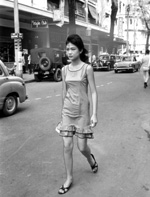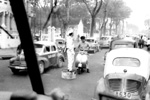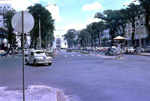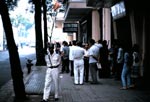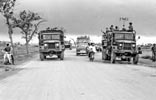
It was November 2nd, 1963, in Saigon
The arrest and assasination of Ngo Dình Diem, then the president of the Republic of Vietnam, was the high point of a coup d’état organized by the CIA and carried out by general Duong Van Minh in November of 1963.
The coup signaled the end of nine years of an autocratic and nepotistic regime in South Vietnam.
Photos by the American doctor Irwin S. Leinbach.
The Vietnamese troops in front of the Parliament building during the putsch of 2 November, 1963.
When the rebel forces entered the presidential palace, the NgĂ´ brothers had already left it the previous night to retreat to their hideout in Cholon
They were summarily executed on 3 November 1963 in the back of an armored transport vehicle by Vietnamese officers during the return to Tan Son Nhut air base headquarters.
This coup was carried out by generals Duong Van Minh, Trân Van Von, Ton Thât Dinh, Lê Van Kim, and Mai Huu Xuân.
General Dong Van Minh takes over the presidency, and the constitution of the First Republic is abolished.
Duong Van Minh, nicknamed “Big”Minh, was a true southerner. He was born 16 February 1916 in MyTho in the Mekong Delta, and was promoted to commander in 1952 having attended the War College in Paris.
In the middle of a Buddhist crisis, Duong Van Minh finds himself at the head of a group of generals who overthrow the the two brothers Diem and Nhu, with the help of the Americans.
In April 1975, President Nguyen Van Thieu is forced to resign and to seek refuge in Taiwan. “Big” Minh takes over and after three days decides to order the surrender of the army of the South to avoid a bloodbath in Saigon.
In 1983 the communists allowed him to rejoin his wife and children who were living in the suburbs of Paris, where he lived very modestly.
On August 6th, 2001, at the age of 86, he died in a Pasadena, California hospital after a fall from his wheelchair.
Duong Van Minh, by his nature, hardly ever became involved in Saigon intrigues, while at the same time being the main rallying point of the opposition for three decades.
Photos by the American doctor Irwin S. Leinbach.
Phan Huy Quat would be the Prime Minister of President Phan Khac Suu for only 4 months in 1965, long enough to authorize massive American landings in Vietnam (March 1965) and to have him replaced by General Nguyen Cao Ky.

It was January 30th, 1968, in Saigon
Saigon was hit on January 31, 1968 starting at 0300h. 4000 Viet Cong, in civilian clothes, backed by units of the Army of North Vietnam attacked virtually all of the South Vietnamese and American government installations. Hundreds of small groups tried to take over the presidential palace, the headquarters of the South Vietnamese army (ARVN), the public radio and television station, police stations, various official entities, and Tan Son Nhut airport. Numerous high-ranking military and police officials as well as American officials were attacked in their private residences.
All of these targets were chosen for their symbolic value and did not represent an organized offensive in the conventional sense.
It was done to create a climate of chaos suitable for the general uprising of the population of Saigon and the south.

In April 1975 Vietnamese refugees leave Saigon.
It was April 30th, 1975, in Saigon
In the beginning of April the region of Saigon is surrounded. After about two weeks fierce fighting, President Thieu resigned on 21 April and was replaced by vice president Tran Van Huong, who in turn is replaced on 28 April by Duong Van Minh, nicknamed the 3-day President.
After the communists refused all negotiation, Duong Van Minh ordered the surrender of all ARVN troops on 30 April. The surrender was accepted by the Republic of North Vietnam while overloaded American helicopters evacuate the city and the first boat people make their appearance.
At 0755h on 30 April, as the last helicopter is taking off from the roof of the American embassy in Saigon, thousands of potential asylum-seekers are still pouring into the gardens.
More than 305,000 refugees will eventually be taken aboard American ships cruising offshore.
The cover of Time magazine for May 12, 1975:
It was July 2nd, 1976, in ...Ho Chi Minh City
Saigon became Ho Chi Minh City in posthumous honor of the guide to the unified Vietnamese nation who died in 1969.
Vietnam is officially reunified under the name of the Socialist Republic of Vietnam.



















